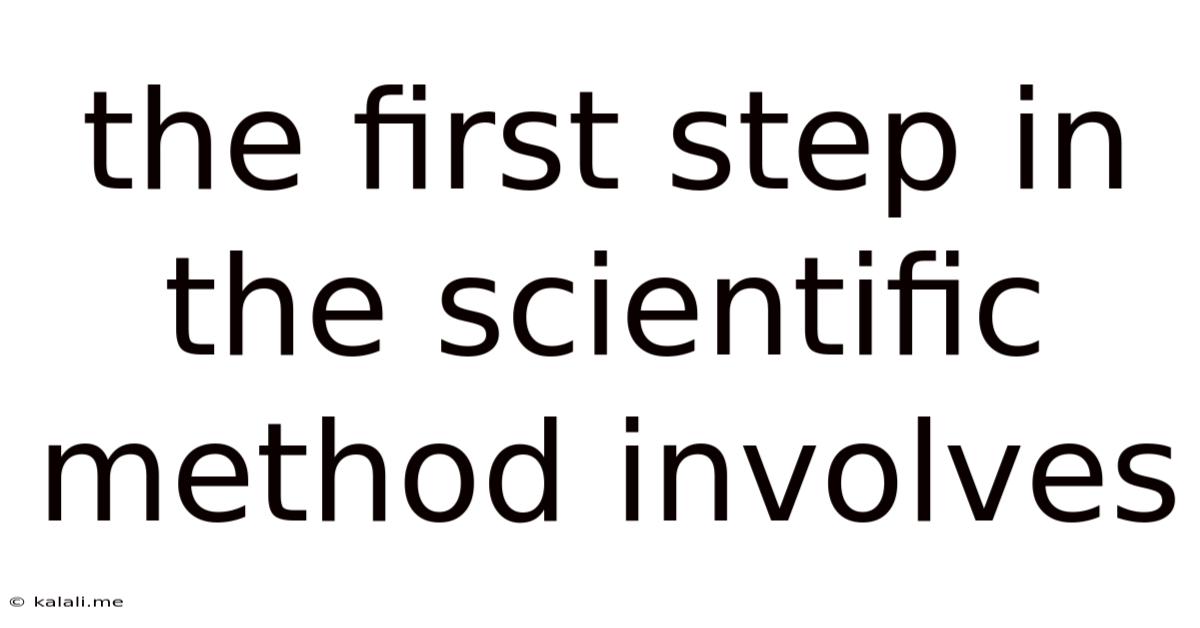The First Step In The Scientific Method Involves
Kalali
Jun 13, 2025 · 3 min read

Table of Contents
The First Step in the Scientific Method: Making Observations
The scientific method is a cornerstone of scientific inquiry, guiding researchers to systematically investigate the world around them. While often presented as a linear process, it's more cyclical and iterative in practice. Understanding each step is crucial, but perhaps the most critical, and often overlooked, is the first: making observations. This seemingly simple step lays the foundation for all subsequent stages of the scientific method. This article will delve into the importance of observation, its various forms, and how it shapes the entire scientific process.
The initial observation isn't just about passively seeing or hearing something; it's about actively engaging with the world and noticing patterns, anomalies, or questions that require investigation. This active observation forms the basis of your hypothesis and subsequent experiment design. A well-defined observation is crucial for creating a focused and impactful research project.
Types of Observations
Observations can be broadly categorized into two types:
-
Qualitative Observations: These observations describe qualities or characteristics, often using descriptive language. For example, noting the color of a solution ("the liquid is blue"), the texture of a material ("the surface is rough"), or the behavior of an organism ("the bird is singing"). These observations are subjective and rely on sensory perception.
-
Quantitative Observations: These observations involve numerical measurements and data. This could include measuring the length of an object (5 cm), the temperature of a substance (25°C), or the weight of a sample (10 grams). Quantitative data is objective and allows for precise analysis. Often, qualitative observations will lead to the need for quantitative data to support a hypothesis.
The Importance of Detailed Observation
The quality of your research hinges on the thoroughness of your initial observations. A superficial observation might lead to inaccurate conclusions, while a meticulous observation provides a stronger foundation for hypothesis formation. Consider these points:
-
Identifying Patterns and Anomalies: Detailed observations help you identify recurring patterns or unexpected deviations from the norm. These patterns can reveal underlying relationships and generate questions to investigate further.
-
Formulating Testable Hypotheses: A strong observation leads to a focused and testable hypothesis. A vague observation will result in a poorly defined and difficult-to-test hypothesis.
-
Designing Relevant Experiments: The type of observation made will directly influence the design of your experiment. Quantitative observations might necessitate controlled experiments, while qualitative observations may require more exploratory approaches.
-
Interpreting Results: Your initial observations will serve as a benchmark against which to compare your experimental results. This comparison allows for accurate interpretation and conclusions.
Examples of Observations Leading to Scientific Discovery
Many scientific breakthroughs have originated from keen observations. For instance, the discovery of penicillin stemmed from Alexander Fleming's observation of a mold inhibiting bacterial growth. Similarly, the theory of gravity was influenced by Newton's observation of a falling apple. These examples highlight the critical role of observation in shaping scientific progress.
Moving Beyond Observation: The Next Steps
Once robust observations are made, the next step in the scientific method involves formulating a hypothesis, a testable explanation for the observed phenomenon. This hypothesis then guides the design and execution of experiments to test its validity. The analysis of the experimental data and the drawing of conclusions complete the cycle, potentially leading to further observations and refinements of the hypothesis.
In conclusion, the first step of the scientific method, making observations, is far from trivial. It requires careful attention to detail, a curious mind, and a systematic approach to gathering information. It's the foundation upon which all subsequent steps are built, directly influencing the quality, validity, and impact of scientific research. Mastering this crucial first step is paramount for any aspiring scientist.
Latest Posts
Latest Posts
-
How Many Pounds Are In 32 Ounces
Jul 01, 2025
-
What Year Would I Be Born If I Was 21
Jul 01, 2025
-
How Many Minutes Are In 40 Hours
Jul 01, 2025
-
How Many Cups Are In 16 Oz Of Sour Cream
Jul 01, 2025
-
How Many Quarters Are In 20 Dollars
Jul 01, 2025
Related Post
Thank you for visiting our website which covers about The First Step In The Scientific Method Involves . We hope the information provided has been useful to you. Feel free to contact us if you have any questions or need further assistance. See you next time and don't miss to bookmark.